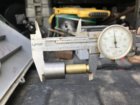I've been looking at gauges for head to shoulder measurements and two options appear to be: (a) the LE Wilson headspace gauge and (b) the Sinclair inserts in the Hornady comparator body. With the Wilson gauge, I can see that it would be easy to check max and min headspace of cases, but I'm wondering whether you can measure the reduction in headspace after resizing--where you'd presumably end up somewhere between max and min on the gauge. But I may be missing something with the Wilson gauge. The Sinclair insert/Hornady comparator body option would seem to make it easier to measure exactly how much you have bumped the shoulder after resizing.
I've never bothered with this in the past. I've just full-length resized and ensured that the cases would chamber without resistance. But I may be over-resizing my cases and would like to have a way to resize them minimally--with minimal shoulder bump, but enough to chamber easily.
What would you guys recommend? There may be better tools out there that I'm unaware of.
I've never bothered with this in the past. I've just full-length resized and ensured that the cases would chamber without resistance. But I may be over-resizing my cases and would like to have a way to resize them minimally--with minimal shoulder bump, but enough to chamber easily.
What would you guys recommend? There may be better tools out there that I'm unaware of.











